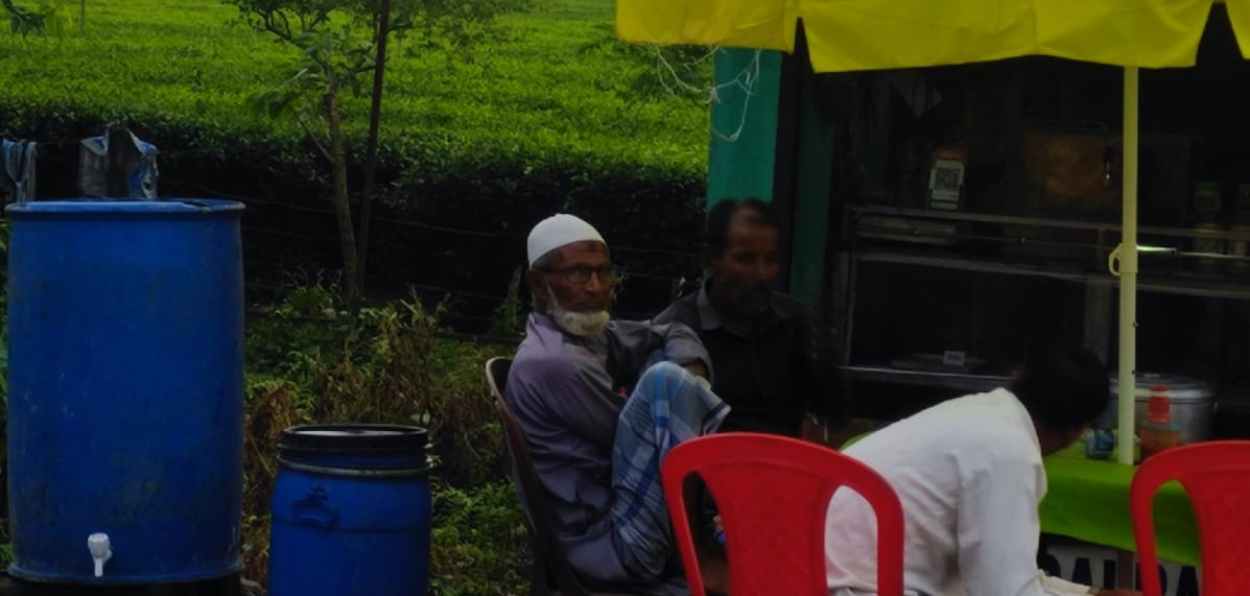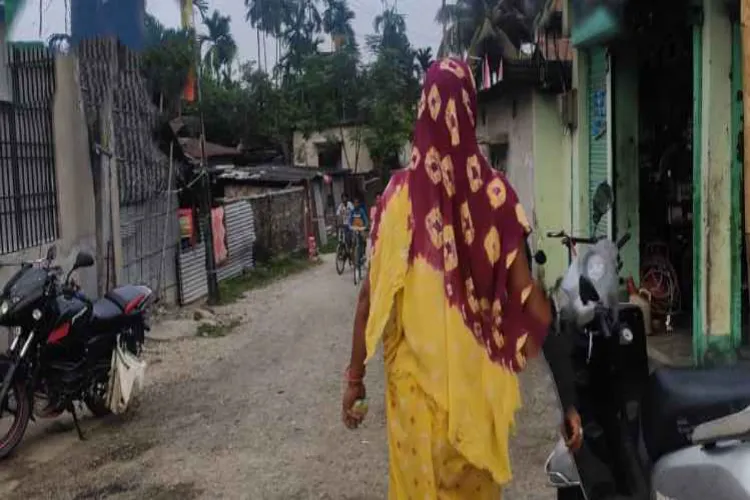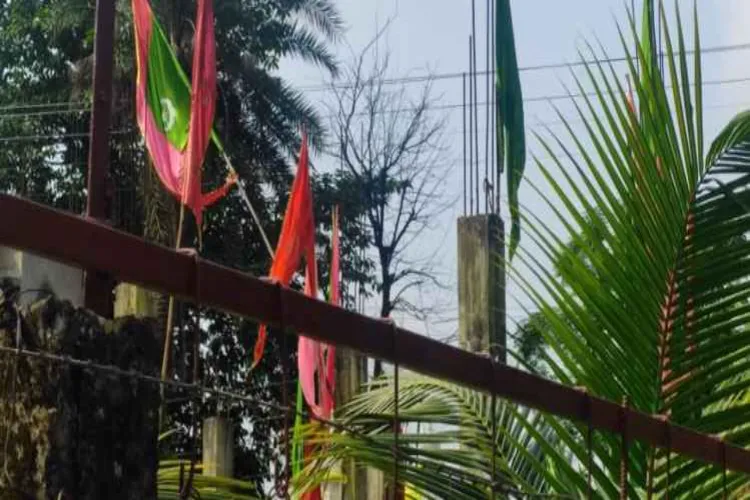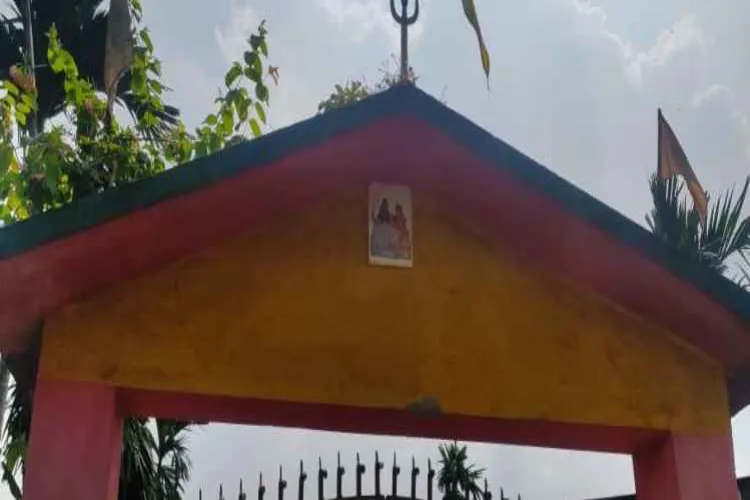
Rita Farhat Mukand
Burrowed next to the National Highway 10 which has been immortalized by the Bollywood thriller -NH10 - running through the sprawling Dagapur Tea Estates of Salbari, one would never notice this coconut grove village.
A step inside across the Darjeeling Toy Train railway track takes one into a whole new world of humans immersed in hustling activities amidst tranquility.
The village Naya Basti with a rather drab and common name, which simply means “new village” is home to around 400 people and turns out to be an exciting hotspot of a cultural mix of people carrying on with dignity and a calm, without any fuss who can teach others the true art of living!
An overall sense of peacefulness pervades the village and is enhanced by the coconut trees swaying in the breeze, with the Dagapur Tea Gardens on the opposite side. A small stall of fried snacks near the tea gardens draws droves of people for a relaxing after long hours of work.

A woman walks through the street of Naya Basti, not willing to show her face to camera
As one steps into the village, the first sight that grips one is an elaborately crafted Tazieh in the center of a lush green lawn. Tazieh, originated from Iran and is a Shia Islamic ritual that symbolically reenacts the tragic events of the massacre on the plains of Karbala, Iraq, in the year 680 AD depicting the martyrdom of Hussein, the beloved grandson of the Islamic Prophet Muhammad, along with his male children and companions.
The village area consists of a long road of uncluttered expanse of tranquility bordered with greenery.
Walking on the heavily potholed roads was a unique experience with saffron and green flags fluttering in the gentle wind outside homes.
There was also a Christian’s home easily identified due to the cross on the door. The houses with gateways ornamented with green and crescent moons or saffron and the deities are captivating.
Most of the houses have traditional courtyards with water taps and hand pumps, some have stacks of stuff they would like to sell one day and logs of wood and sticks heaped upon each other. All this creates an old-world charm.
The Muslim-dominant village is home to some 400 people coming from different communities living together in harmony for approximately four decades. The villagers are from different walks of life and go out to work holding jobs such as auto rickshaw drivers, plumbers, small shop owners, artisans, and vendors selling chickens and eggs. Some also manage food kiosks outside in the city nearby where they sell fried rice, noodles, fried chicken, and various other eateries.

Naya Basti houses have saffron and green flags denoting the religion of the owners
The narrow street is dotted with tiny shops. Shopkeepers peacefully sell their commodities amid children playing quietly while some women sit outside their home doors talking to each other and some sit quietly lost in their thoughts.
Education is the key element shaping the lives of girls in Naya Basti, with the majority of them attending school. As they returned from school, dressed in hijabs and carrying school bags slung across their shoulders, chatting happily among themselves, they appeared confident and content, armed with education, to go further and pursue dreams in life.
Understandably, the village folk, and especially the women are a little reticent to opening up about their lives before outsiders, and taking their pictures was an absolute taboo, and some of them spoke based on anonymity.
They love their homes and streets and for many of the women here, the outside world is dangerous and alien. They feel safe within the village boundary. The village pond is their world as it offers them peace, happiness, and safety.
While many men go out to work and quietly deal with the ups and downs and challenges in a competitive world, most of the women are homemakers and they are busy tending to their homes and children.
Draped in her soft pink hijab, Sayema Begum (Name changed on request) sat outside her house when I met her. She was initially hesitant to engage in conversation, as many find inquiries about their lives intrusively personal.
Eventually, she drew a deep breath and shared, "We arrived here four decades ago when we acquired land in this village. We've peacefully coexisted for years, Hindus, Muslims, and Christians. Whenever challenges arise, we unite to support one another."

House of local saropanch of Naya Basti
She went on to say, "We tend to each other's needs. When illness strikes, we offer assistance. Hindus and Christians also join us in celebrating Eid, just as we partake in their festival joy and gatherings.”
Samina, a lean Hindu woman, shared her profound wisdom while speaking with me. She said, "We've coexisted for many years. We're all alike, human beings. How we perceive one another depends on the perspective of others; they shape it as they see fit."
Samina had once worked as a household assistant but stopped working due to a debilitating illness that had made her lose weight. She appeared on the verge of tears as she spoke about leaving her work, and it seemed she was missing the days of work.
Samina lives in a spacious joint-family home that appears substantial from the outside, and her daily routines of simple tasks likely kept her engaged throughout the day.
Another woman accompanying Samina said, "We're all engrossed in managing our households and careers, leaving us little time for conversations with others. Our lives are mostly centered around our responsibilities."
Robiel, a young auto driver who appeared to be around 19, took a brief pause from his bustling auto-driving business to convey that in Naya Basti, everyone was deeply engrossed in their work, experiencing collective happiness and harmony while sharing numerous joyful moments. Robiel's sentiments resonated with many within the village community.
What strikes one is these are diverse individuals with distinct lives from different communities, each engaged in their daily routines, collaboratively shaping a meaningful existence. Every evening, they return to their homes, feeling secure within their fortifications.
ALSO READ: Durga Puja: Divine moment of ‘Sandhi Puja’, ‘Pushpanjali’ and traditional ‘Bhog’ Mahaashtami
With their houses painted green or saffron, and a few even had Christian crosses embellished on their doors, it was fascinating to observe how the different communities living together firmly mark their differences on their doors and walls yet live together in peaceful solidarity and unity.
